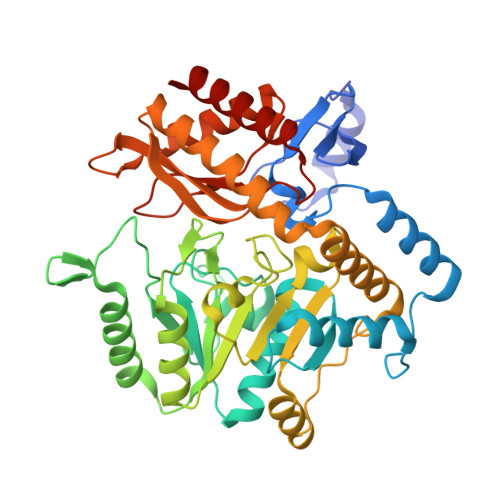Role of q52 in catalysis of decarboxylation and transamination in dialkylglycine decarboxylase.
Fogle, E.J., Liu, W., Woon, S.T., Keller, J.W., Toney, M.D.(2005) Biochemistry 44: 16392-16404
- PubMed: 16342932
- DOI: https://doi.org/10.1021/bi051475b
- Primary Citation of Related Structures:
1Z3Z, 1ZC9 - PubMed Abstract:
Dialkylglycine decarboxylase (DGD) is a pyridoxal phosphate dependent enzyme that catalyzes both decarboxylation and transamination in its normal catalytic cycle. DGD uses stereoelectronic effects to control its unusual reaction specificity. X-ray crystallographic structures of DGD suggest that Q52 is important in maintaining the substrate carboxylate in a stereoelectronically activated position. Here, the X-ray structures of the Q52A mutant and the wild type (WT) DGD-PMP enzymes are presented, as is the analysis of steady-state and half-reaction kinetics of three Q52 mutants (Q52A, Q52I, and Q52E). As expected if stereoelectronic effects are important to catalysis, the steady-state rate of decarboxylation for all three mutants has decreased significantly compared to that of WT. Q52A exhibits an approximately 85-fold decrease in k(cat) relative to that of WT. The rate of the decarboxylation half-reaction decreases approximately 10(5)-fold in Q52I and approximately 10(4)-fold in Q52E compared to that of WT. Transamination half-reaction kinetics show that Q52A and Q52I have greatly reduced rates compared to that of WT and are seriously impaired in pyridoxamine phosphate (PMP) binding, with K(PMP) at least 50-100-fold greater than that of WT. The larger effect on the rate of l-alanine transamination than of pyruvate transamination in these mutants suggests that the rate decrease is the result of selective destabilization of the PMP form of the enzyme in these mutants. Q52E exhibits near-WT rates for transamination of both pyruvate and l-alanine. Substrate binding has been greatly weakened in Q52E with apparent dissociation constants at least 100-fold greater than that of WT. The rate of decarboxylation in Q52E allows the energetic contribution of stereoelectronic effects, DeltaG(stereoelectronic), to be estimated to be -7.3 kcal/mol for DGD.
Organizational Affiliation:
Department of Chemistry, University of California, Davis, California 95616, UA.

















